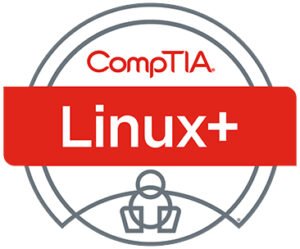Course Length: 5 days
Course Description
CompTIA Linux+ validates the skills administrators need to secure the enterprise, power the cloud and keep systems running. The new certification ensures that IT professionals, software developers, cybersecurity engineers and penetration testers have these necessary skills to support today’s tech systems. This course will prepare you to take the Linux+ Certification Exam (XK0-005).
Course Objectives:
- After course completion, you will be able to
- Describe history and features of Linux
- Manage files and directories
- Describe foundational concepts of documentation
- Desbribe foundational concepts of troubleshooting
- Implement identity management
- Configure and execute remote connectivity for system management
- Analyze and troubleshoot user access and file permissions
- Apply the appropriate access controls
- Create simple shell scripts to automate common tasks
- Build and install software
- Manage software configurations
- Summarize Linux fundamentals
- Use the appropriate networking tools or configuration files
- Analyze and troubleshoot storage issues
- Analyze and troubleshoot central processing unit (CPU) and memory issues
- Configure and use the appropriate processes and services
- Use of security best practices in a Linux environment
- Use systemd to diagnose and resolve common problems with a Linux system
- Analyze and troubleshoot network resource issues
- Implement and configure firewalls
- Summarize common infrastructure as code technologies
- Perform basic version control using Git
- Perform basic container operations
- Summarize container, cloud, and orchestration concepts
Target Audience
This course is suited for these roles:
Linux Administrator
Junior Cloud Engineer
Junior DevOps Support Engineer
Technical Support Specialist
Systems Administrator
Network Administrator
Web Administrator/ Developer
Cybersecurity Engineer
Linux Engineer
Prerequisites:
Other Prerequisites:
It is recommended that prior to taking this course, you have taken CompTIA A+, CompTIA Network+ and have 12 months experience as a Junior Linux Engineer
Course Content
1 - LESSON 1: INTRODUCING LINUX
- Topic 1A: Identify Linux Characteristics
- Topic 1B: Understand Bash Interaction with Linux
- Topic 1C: Use Help in Linux
- Topic 1D: Identify the Linux Troubleshooting Methodology
2 - LESSON 2: ADMINISTERING USERS AND GROUPS
- Topic 2A: Manage User Accounts
- Topic 2B: Manage Group Accounts
- Topic 2C: Configure Privilege Escalation
- Topic 2D: Troubleshoot User and Group Issues
3 - LESSON 3: CONFIGURING PERMISSIONS
- Topic 3A: Configure Standard Linux Permissions
- Topic 3B: Configure Special Linux Permissions
- Topic 3C: Configure Access Control Lists
4 - LESSON 4: IMPLEMENTING FILE MANAGEMENT
- Topic 4A: Understand the Linux File System
- Topic 4B: Use File Management Commands
- Topic 4C: Find File Locations
5 - LESSON 5: AUTHORING TEXT FILES
- Topic 5A: Edit Text Files
- Topic 5B: Manage Text Files
6 - LESSON 6: MANAGING SOFTWARE
- Topic 6A: Understand Software Management
- Topic 6B: Manage RPM Software Packages and Repositories
- Topic 6C: Manage Debian-based Software Packages and Repositories
- Topic 6D: Compile from Source Code
- Topic 6E: Acquire Software
- Topic 6F: Run Software in a Sandbox
7 - LESSON 7: ADMINISTERING STORAGE
- Topic 7A: Understand Storage
- Topic 7B: Deploy Storage
- Topic 7C: Manage Other Storage Options
- Topic 7D:Troubleshoot Storage
8 - LESSON 8: MANAGING DEVICES, PROCESSES, MEMORY, AND THE KERNEL
- Topic 8A: Gather Hardware Information
- Topic 8B: Manage Processes
- Topic 8C: Manage Memory
- Topic 8D: Manage the Linux Kernel
9 - LESSON 9: MANAGING SERVICES
- Topic 9A: Manage System Services
- Topic 9B: Configure Common System Services
- Topic 9C: Configure Localization Settings
10 - LESSON 10: CONFIGURING NETWORK SETTINGS
- Topic 10A: Understand Network Fundamentals
- Topic 10B: Manage Network Settings
- Topic 10C: Configure Remote Administrative Access
- Topic 10D: Troubleshoot the Network
11 - LESSON 11: CONFIGURING NETWORK SECURITY
- Topic 11A: Configure the Firewall
- Topic 11B: Monitor Network Traffic
12 - LESSON 12: MANAGING LINUX SECURITY
- Topic 12A: Harden a Linux System
- Topic 12B: Manage Certificates
- Topic 12C: Understand Authentication
- Topic 12D: Configure SELinux or AppArmor
13 - LESSON 13: IMPLEMENTING SIMPLE SCRIPTS
- Topic 13A: Understand Bash Scripting Basics
- Topic 13B: Use Shell Script Elements
- Topic 13C: Implement Scripts with Logical Controls
14 - LESSON 14: USING INFRASTRUCTURE AS CODE
- Topic 14A: Understand Infrastructure as Code
- Topic 14B: Implement Orchestration
- Topic 14C: Manage Version Control with Git
15 - LESSON 15: MANAGING CONTAINERS IN LINUX
- Topic 15A: Understand Containers
- Topic 15B: Deploy Containers
- Topic 15C: Understand Virtualization Concepts
16 - LESSON 16: INSTALLING LINUX
- Topic 16A: The Linux Boot Process
- Topic 16B: Modify Boot Settings
- Topic 16C: Deploy Linux


